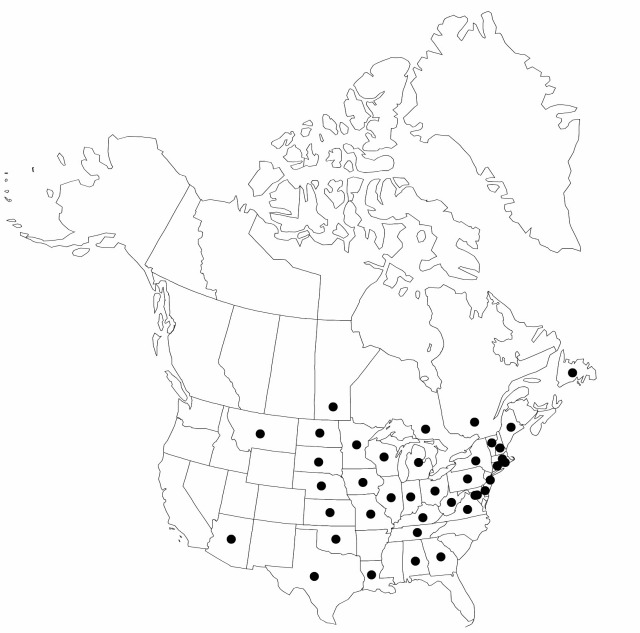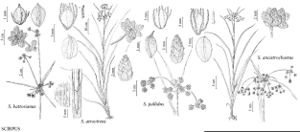Scirpus atrovirens
Enum. Pl. 1: 79. 1809.
Plants cespitose; rhizomes short, tough, fibrous. Culms: fertile ones upright or nearly so; nodes without axillary bulblets. Leaves 6–11 per culm; sheaths of proximal leaves light brown; proximal sheaths and blades with septa many, ± conspicuous; blades 20–54 cm × 7–17 mm. Inflorescences terminal, rarely also with 1 lateral inflorescence from distal leaf axil; rays ascending or divergent (commonly both in the same inflorescence), proximal branches smooth, distal branches scabrellous to scabrous, rays often bearing axillary bulblets; bases of involucral bracts green, margins usually speckled with red-brown, rarely solid black, not glutinous. Spikelets in dense clusters of 4–110 (largest cluster with 17–25+), spikelets sessile, ovoid to narrowly ovoid, 2–5(–8) × 1–2.5 mm; scales dark brown with pale midribs, elliptic or broadly elliptic (rarely almost circular), 1.2–2.1 mm, apex mucronate, mucro 0.1–0.3(–0.4) mm. Flowers: perianth bristles persistent, (5–)6, rather stout to somewhat slender, straight or curved, shorter than to slightly exceeding achene, with retrorse, thin-walled, round-tipped barbs in distal 0.3–0.6, enclosed within scales; styles 3-fid. Achenes light brown, elliptic or obovate in outline, plumply trigonous or plano-convex, (0.8–)1–1.3 × 0.4–0.6 mm. 2n = 50–60.
Phenology: Fruiting late spring–early summer (late Jun–Jul).
Habitat: Marshes, moist meadows
Elevation: 0–900 m
Distribution

Man., Nfld. and Labr. (Nfld.), Ont., Que., Ala., Ariz., Conn., Del., D.C., Ga., Ill., Ind., Iowa, Kans., Ky., La., Maine, Md., Mass., Mich., Minn., Mo., Mont., Nebr., N.H., N.J., N.Y., N.Dak., Ohio, Okla., Pa., R.I., S.Dak., Tenn., Tex., Vt., Va., W.Va., Wis.
Discussion
Scirpus atrovirens is variable and often confused with all of its close relatives: S. georgianus, S. flaccidifolius, S. hattorianus, and S. pallidus. The septa in the blades and sheaths of the proximal leaves tend to be more prominent in S. atrovirens than in any of the related species, so that the leaves and sheaths appear distinctly nodulose in dried specimens. The scales have relatively little black pigmentation, so that the heads appear brownish, not blackish as in S. pallidus, S. hattorianus, and S. flaccidifolius.
Scirpus atrovirens occasionally hybridizes with S. georgianus, S. hattorianus, S. pallidus, and S. polyphyllus.
Selected References
None.
